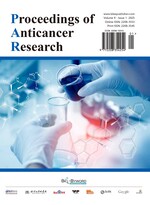The Predictive Value of SPP1 Gene Expression for the Survival of Advanced Liver Cancer Treated with Transarterial Chemoembolization
Abstract
Objective: To evaluate the predictive value of secreted phosphoprotein 1 (SPP1) gene expression for postoperative survival in patients with advanced liver cancer undergoing hepatic artery interventional chemoembolization treatment. Method: Bioinformatics methods, including gene ontology (GO) and Kyoto Encyclopedia of Genes and Genomes (KEGG) pathway analysis, were used to identify genes related to survival prognosis in hepatocellular carcinoma (HCC) patients. A retrospective analysis of 115 advanced liver cancer patients treated between January 2016 and October 2017 was conducted. Patients were categorized into SPP1 high-expression (n = 89) and low-expression groups (n = 26). Additionally, 115 healthy individuals served as the control group. The relationship between SPP1 expression and clinical pathological features was analyzed. A 60-month follow-up and logistic regression analysis identified risk factors affecting survival. Results: SPP1 mRNA expression was significantly higher in liver cancer patients compared to healthy controls (P < 0.05). SPP1 expression levels were significantly associated with tumor size, Child-Pugh grading, lymph node metastasis, and BCLC staging (P < 0.05). High SPP1 expression, along with tumor size, Child-Pugh grading, lymph node metastasis, and BCLC staging, were independent risk factors for survival (P < 0.05). The 60-month survival rate was 17.39%, with a median survival of 40 months in the low-expression group versus 18 months in the high-expression group (P < 0.05). Conclusion: SPP1 expression is significantly upregulated in advanced liver cancer patients and has predictive value for postoperative survival following hepatic artery chemoembolization treatment. SPP1, combined with clinical indicators such as tumor size, Child-Pugh grading, lymph node metastasis, and BCLC staging, may serve as a prognostic biomarker for interventional treatment outcomes.
References
Huang G, Li Z, Ding X, 2022, The Transcription Factor AP-2α Regulates the Expression of SOX9 Gene. Chinese Journal of Laser Biology, 31(6): 512–517.
Pu G, Xu Y, Gong R, et al., 2022, The Diagnostic Value of AFP Combined with ALT and T-Bil Detection in Hepatocellular Carcinoma. Western Medical Journal, 34(2): 304–308 + 312.
Han X, 2022, The Impact of CRISPR/Cas9 Mediated SPP1 Gene Knockout on the Biological Functions of Prostate Cancer Cells, dissertation, Zhengzhou University.
Kim TH, Kim H, Joo I, et al., 2020, Combined Hepatocellular-Cholangiocarcinoma: Changes in the 2019 World Health Organization Histological Classification System and Potential Impact on Imaging-Based Diagnosis. Korean J Radiol, 21(10): 1115–1125. https://doi.org/10.3348/kjr.2020.0091
Chen YG, Yang CW, Chung CH, et al., 2022, The Association Between Metabolic Risk Factors, Nonalcoholic Fatty Liver Disease, and the Incidence of Liver Cancer: A Nationwide Population-Based Cohort Study. Hepatol Int, 16(4): 807–816. https://doi.org/10.1007/s12072-021-10281-9. Erratum in Hepatol Int, 16(2): 488. https://doi.org/10.1007/s12072-022-10308-9
Thüring J, Rippel O, Haarburger C, et al., 2020, Multiphase CT-based Prediction of Child-Pugh Classification: A Machine Learning Approach. Eur Radiol Exp, 4(1): 20. https://doi.org/10.1186/s41747-020-00148-3
Bray F, Ferlay J, Soerjomataram I, et al., 2018, Global Cancer Statistics 2018: GLOBOCAN Estimates of Incidence and Mortality Worldwide for 36 Cancers in 185 Countries. CA Cancer J Clin, 68(6): 394–424. https://doi.org/10.3322/caac.21492. Erratum in CA Cancer J Clin, 70(4): 313. https://doi.org/10.3322/caac.21609
Liu C, Yu J, Wu P, 2022, Research Progress on the Treatment of Advanced Primary Liver Cancer. Shandong Medical Journal, 62(28): 91–95.
Anwanwan D, Singh SK, Singh S, et al., 2020, Challenges in Liver Cancer and Possible Treatment Approaches. Biochim Biophys Acta Rev Cancer, 1873(1): 188314. https://doi.org/10.1016/j.bbcan.2019.188314
Liu M, Liu L, 2021, Analysis of the Expression and Clinical Significance of Type 10 Collagen Alpha 1 Chain and Secreted Phosphoprotein 1 in Lung Adenocarcinoma Based on Multiple Datasets. Cancer Progression, 19(24): 2540–2543 + 2577.
Zhang D, Xu J, 2021, Differential Expression and Mechanism of SPP1 in Non-Small Cell Lung Cancer. Journal of Clinical Pulmonary Medicine, 26(11): 1724–1729.
Yan B, Bai DS, Qian JJ, et al., 2020, Differences in Tumour Characteristics of Hepatocellular Carcinoma between Patients With and Without Cirrhosis: A Population-based Study. J Cancer, 11(19): 5812–5821. https://doi.org/10.7150/jca.46927
Guo D, Liu B, Liu B, 2021, Value Analysis of Gadolinium Diamine Enhanced MRI and CT in the Diagnosis of Child Pugh A Hepatocellular Carcinoma with Liver Function. Liver, 26(11): 1264–1267.
Kong J, Li H, Zeng X, et al., 2022, Clinical and Pathological Characteristics and Prognostic Analysis of Regional Lymph Node Metastasis in Primary Liver Cancer. Chinese Journal of Cancer Prevention and Treatment, 29(4): 290–295 + 301.
Luan Y, Liang C, Han Q, et al., 2022, The Expression of SPP1 Gene in Lung Adenocarcinoma and Its Correlation with Prognosis. Journal of Clinical Pulmonary Medicine, 27(6): 884–891.

